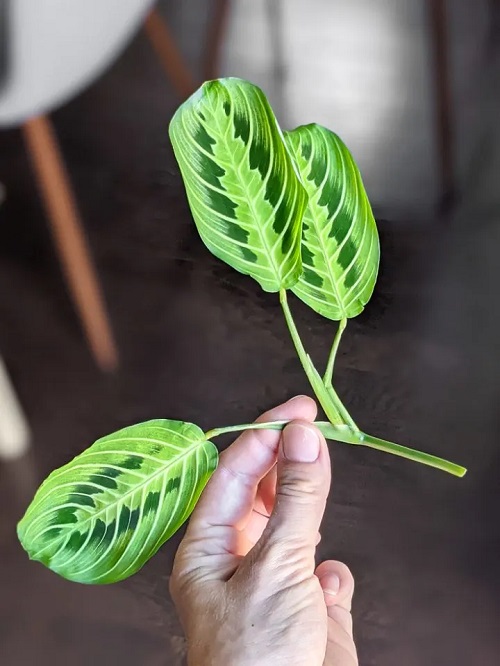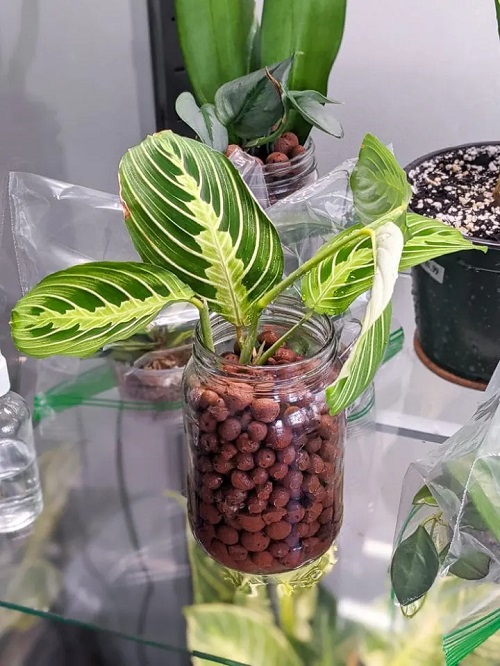Here’s all you need to know about How to Propagate Calathea Plant – one of the best variegated indoor green specimens!
If you’ve been captivated by the intricate patterns and lush colorsand wondering – How to Propagate Calathea Plant, then you’re in the right place. Whether you’re a seasoned plant parent or a beginner looking to expand your indoor jungle, you’ll find that propagating Calathea is a rewarding experience! Scroll down to uncover step-by-step methods.
When To Propagate Calathea Plants
The best time to propagate Calathea plants is in the late spring to early summer when they are in their active growing phase. This is when the plant is most robust and can handle the stress of propagation better. After propagation, the new plants have the entire growing season to establish themselves before the lower light levels and temperatures of winter.
However, if you provide the right conditions – warmth, humidity, and indirect light – Calathea can technically be propagated at any time of the year. Just keep in mind that propagation may take longer in the cooler, darker months, and the plants may not grow as vigorously until spring and summer.
How to Propagate Calathea Plant
1. Propagation by Division
This is the most common and easiest method of Calathea propagation, as it involves simply splitting the plant into smaller parts during repotting. The best time to do this is in the spring or early summer when the plant is actively growing.
Here are the steps:
- Remove the plant from its pot: Be careful not to damage the roots as you do this. Gently pull apart the root ball to expose the roots and the base of the stems.
- Identify divisions: Look for natural divisions in the plant where it can be separated into two or more plants. Each division should have at least one stem and plenty of roots.
- Separate the divisions: Use your fingers or a sharp, clean knife to separate the divisions. Make sure each division has a good amount of healthy roots attached to it.
- Plant the divisions: Pot each division in fresh potting soil that’s well-draining and rich in organic matter. Calatheas prefer slightly acidic to neutral pH. Make sure the pots have drainage holes to prevent waterlogging.
- Water and care for your new plants: Water the new plants thoroughly, and keep them in a warm, humid environment away from direct sunlight. Keep the soil consistently moist, but not waterlogged.
2. Propagation by Stem Cuttings
While this method is less commonly used for Calatheas, it’s still possible. This method involves cutting a piece of stem from the parent plant and encouraging it to develop its own roots in water or soil.
Here are the steps:
- Take a cutting: Using a sharp, sterilized knife or pair of scissors, cut a 4-6 inch section of stem from the parent plant. Make sure the cutting has at least one leaf, and cut just below a leaf node (where a leaf joins the stem and where new roots will grow).
- Prepare the cutting: Remove the leaves from the bottom 2 inches of the cutting.
- Root the cutting: You can root the cutting in water or directly in soil. If using water, place the cut end of the stem in a jar of water and keep it in a warm, brightly lit location. Replace the water every few days. If using soil, dip the cut end in rooting hormone (this is optional, but can help stimulate root growth), then place it in a pot of moist potting soil.
- Wait for roots to grow: This will take a few weeks. If rooting in water, you’ll see the roots grow from the leaf nodes. Once the roots are a couple of inches long, you can transplant the cutting to a pot with soil.
- Care for the new plant: Like with division, keep your new plant in a warm, humid environment with indirect light, and keep the soil consistently moist.
How to Propagate Calathea Plant – Quick Tips For Successful Results

- Thoroughly water your Calathea 24-30 hours before you decide to divide the plant. It helps in reducing transplant stress.
- It is best to prepare the containers in advance. Fill each container halfway with coco coir or peat moss and perlite in a 2:1 ratio.
- Cut off any damaged or diseased parts from the roots or other plant parts while dividing.
- Water the newly potted Calathea plants thoroughly and let the excess water drain out.
- Use plastic bags to cover the propagation tray or pots to retain humidity and warmth.
- Keep a close eye on your new plants for a few weeks after propagation. Monitor their water requirements, look out for signs of disease or pest infestation, and adjust their light levels if necessary.
How to Propagate Calathea Plant – FAQs
1. What is the best time to propagate Calathea?
The best time to propagate Calathea plants is during the late spring or early summer when the plant is in its active growth phase.
2. What are the different methods to propagate Calathea?
The most common method for propagating Calathea is by division. This involves separating a portion of the plant, complete with roots, from the parent plant and replanting it.
3. Do I need to use rooting hormone?
Rooting hormone is generally not necessary for Calathea propagation through division, as the divided sections will already have roots.
4. How long does it take for Calathea to root after propagation?
Depending on the growing conditions, Calathea divisions may take several weeks to establish a strong root system. Optimal humidity and temperature can accelerate this process.
5. Can I propagate Calathea from leaf cuttings?
Calathea is typically not propagated through leaf cuttings; division is the preferred method. Leaf cuttings often fail to produce a viable plant.
6. How do I care for the new Calathea plant after propagation?
Newly propagated Calathea plants should be kept in high humidity and indirect light until they have established their root systems. After that, you can treat them as you would a mature Calathea.
7. What type of soil is best for propagating Calathea?
Use a well-draining soil mix that retains moisture but doesn’t stay waterlogged. A mix of potting soil, perlite, and coco coir can work well.
8. How often should I water the newly propagated Calathea?
Water the new plant enough to keep the soil moist but not soggy. Overwatering can lead to root rot.
9. Can I propagate any type of Calathea?
Most Calathea varieties can be propagated using the division method. However, some specific types may have unique requirements, so it’s best to research your particular variety.
10. Is it normal for Calathea leaves to droop after propagation?
Some leaf drooping is normal due to the stress of transplantation. The plant should recover within a week or two with proper care.





